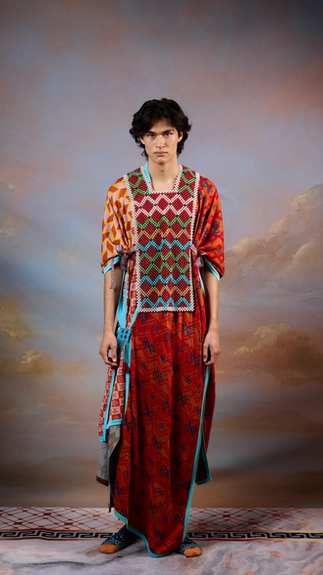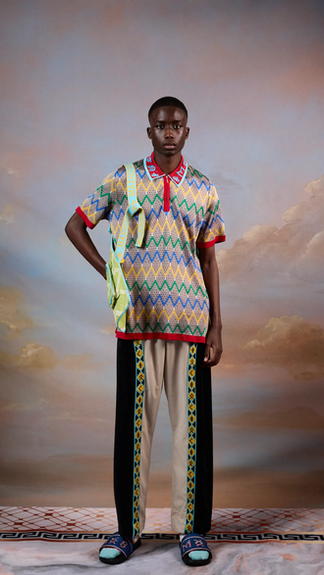MaXhosa’s SS26 Collection: A Love Letter to African Heritage
- BY ELLE NKOSI

- Oct 6
- 3 min read

When the lights dimmed at the Lycée Saint-Louis-de-Gonzague in Paris, something sacred stirred in the air. Models emerged draped in cascades of colour and texture so rich it felt less like a runway and more like a cultural awakening. This was Izipho Zabadala (Gifts for the Ancestors), the Spring/Summer 2026 collection by MaXhosa Africa.
As the only Africa-based brand on the official Paris Fashion Week calendar, the South African luxury house stood as both messenger and movement, reminding the world that heritage is not history. It’s living art.
Founder and visionary designer Laduma Ngxokolo has spent fifteen years threading culture into contemporary design, one motif at a time. Known for his intricate use of colour, geometry, and symbolism rooted in Xhosa tradition, Laduma describes his mission simply: to bring African culture into the global luxury lexicon without losing its soul. “MaXhosa is a cultural brand,” he said backstage. “The techniques we choose are our way of expressing that.”
This season, that expression took on a new level of intimacy. Izipho Zabadala is more than a collection, it’s a love letter to the elders and ancestors who came before, those whose artistry and wisdom still shape the creative pulse of the continent. Each look felt ceremonial, a tactile praise rendered in knit and beadwork.
But the beauty wasn’t just in the clothes. The show opened with a moment of silence honoring South Africa’s ambassador to France, Nathi Mthethwa, who passed away in Paris earlier that week. The gesture grounded the show in reverence, transforming fashion into a form of collective remembrance.
Over thirty looks moved down the runway, revealing a visual language of gratitude and reinvention. Layers of ruffles, some echoing traditional bead patterns, spilled over graphic jackets detailed with pulled-thread embellishments. Distressed and “glitch” effects hinted at the dialogue between old and new, between handmade imperfection and digital precision.
Accessories were an extension of identity. There were block sandal heels that felt nostalgically familiar, like something your stylish aunt might wear, kitten heels detailed with white fur, and men’s slides paired with socks. Bags told their own stories: crossbody beaded purses, and structured briefcases wrapped in MaXhosa’s signature patterns. Even the bucket hats carried cultural weight, bridging streetwear with ceremonial symbolism.
Another standout look featured a two-piece ensemble paired with an isicholo, the traditional Zulu women’s hat, finished with delicate fringes on the sides and forehead. The look was completed with a striking red rectangular tie bearing the inscription “Izipho Zabantu Abadala” (the gifts of those who came before.)
The palette was a study in vibrancy; burnt orange, ocean blue, gold, emerald, and hints of white balancing the visual rhythm. Laduma knows that colour is language, and his fluency in it is unmatched, “African culture is a universal language,” he said, “We’re trying to get a signature out there that is distinctive and unique and that truly represents South Africa. Our community understands it. I want to bring that culture to the table.”
Then came the show’s breathtaking finale. Legendary singer Yvonne Chaka Chaka closed the presentation, wearing what could only be described as the queen’s dress. Her gown; embellished with side fringes, was finished with an overtop draped across the shoulders, patterned in MaXhosa’s iconic motifs. Her headpiece, a queen-mother hair covering adorned with beads cascading like a fringe, sealed the collection’s message perfectly. In that moment, Gifts of the Elders wasn’t just a title; it became a living scene of reverence.
Laduma's attention to cultural detail went beyond fashion, it was about dialogue. Every silhouette, fabric choice, and accessory carried the echo of the continent’s storytelling. Even the beauty direction honoured that heritage: bold, cheekbone-height blush makeup look paired with architectural braids inspired by African design forms.
From Paris to Johannesburg, MaXhosa SS26 served as both fashion and tribute. This marked MaXhosa’s fourth season on the official Paris Fashion Week schedule, standing proudly alongside houses like Hermès and Balenciaga. Yet its energy felt singular, less about competing on the global stage and more about expanding it to include the stories, textures, and voices of Africa.
Izipho Zabadala bridges past and present, weaving personal memory with universal symbolism. “Every garment speaks across time,” Laduma explained. “They act as antennas; vessels through which we honour our ancestors, showing them that their gifts endure.”
And indeed, they do. From Michelle Obama to Beyoncé, from Alicia Keys to Zozibini Tunzi, MaXhosa has found admirers who wear its message as much as its patterns. Yet even in the glow of celebrity endorsement, Ngxokolo remains anchored in purpose. His work isn’t about fame; it’s about continuity. About reminding us that the future of luxury doesn’t erase where we come from; it honours it.






























































































































